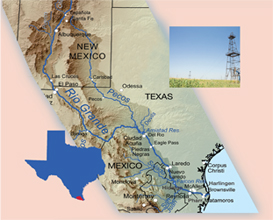“There are farmers who left some ground fallow this year because they didn’t have enough water to plant a crop,” he says. “The long-term answer for us in Texas is to do a better job of working with irrigation districts, to be more mindful of how we use the water we have, and to improve the infrastructure of our water delivery systems.”
Water has also been an issue for Chad Szutz at A-W Produce Company in Weslaco. The business, which grows in four different water districts, has had to deal with multiple allocation issues and restrictions. To combat the shortage, the company turned to drip irrigation on much of its acreage years ago; more recently, it began using drip irrigation for its onions and watermelons, two of its largest crops.
While Szutz remains circumspect about the challenge, he also admits it is probably the new normal. “I’m sure we’ll have better times,” he says. “But between the population growth and the demand for year-round produce, water will always be an issue in the future.”
For Vázquez of Latin Specialties, the lack of a stable and dependable workforce is one of the biggest problems across the industry. Over the past several years, employee turnover has increased dramatically. He points to immigration reform and labor issues—and the Congressional roadblocks to tackling the problems—as frustrating flies in the ointment. “When it comes to immigration reform, other company owners second my concerns for finding a reliable workforce and express a complete disillusionment with the lack of action and leadership from the federal government,” he says. “As someone once said, ‘People don’t raise their children to be farmers, and farmers don’t raise their children to be farmers.’ Who will raise and handle our food in the future? I am not sure.”
While south Texas enjoys a steadier supply of labor than the rest of the state, the produce industry is seeing some of its able bodies exit for the oil fields, with the promise of higher pay. And even as some Mexican companies set up operations in the Valley, Erikson sees many U.S. companies, spurred by the ongoing lack of immigration reform, increasingly moving their growing operations south.
García of Sweet Seasons agrees. During his regular trips to Mexico, he has noted an increase in the acres planted. “I know many U.S. companies now have permanent Mexico programs,” he says. “It used to be just seasonal, but honestly, it’s more cost-effective to grow down there and there’s plenty of labor.” Some labor problems may be remedied, however, if President Obama is successful in his plans for immigration reform.
Also related to the labor shortage is a steady decline in agricultural production across the region. According to the Texas Department of Agriculture, the state is losing an average of 200 acres per day of agricultural production land, which also includes livestock. Industry leaders point to suburbanization and overdevelopment, labor challenges, invasive pests, and political gridlock as the causes.



